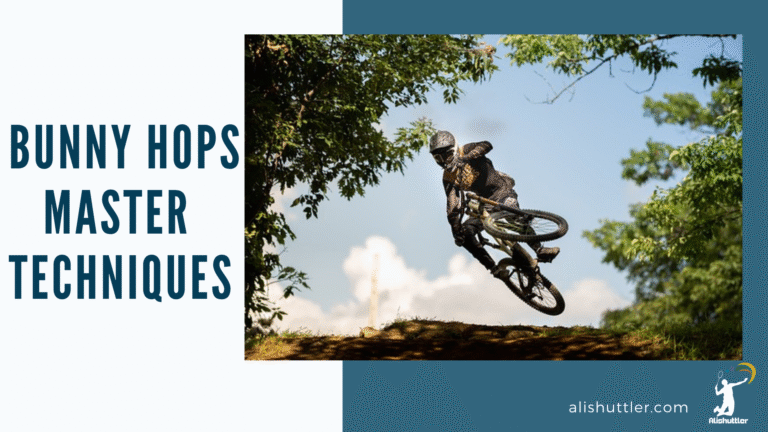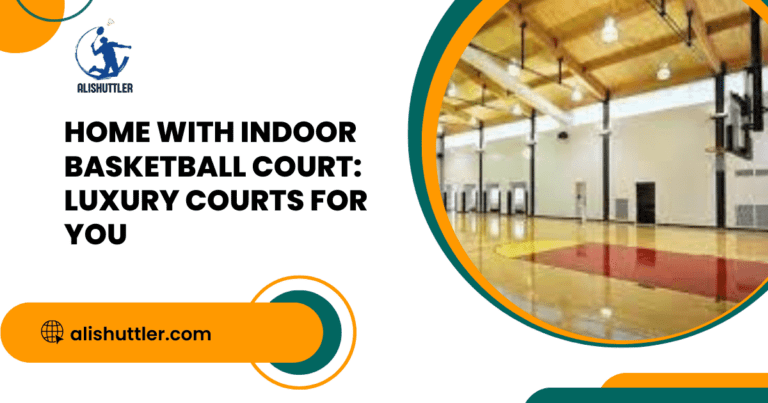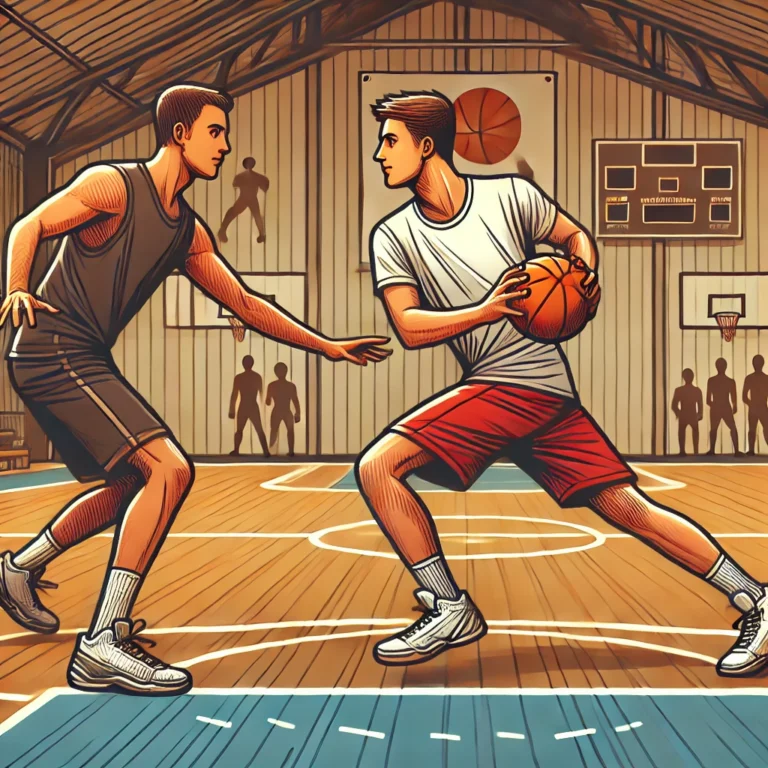Flooring for basketball courts signifies durable, sleek floors designed for secure gameplay and optimal ball rebound. Most courts have maple wood floors, but some also feature synthetic or rubber flooring.
The right Flooring for a basketball court protects players and assists with grip, velocity, and impact absorption. Indoor and outdoor courts require different types to withstand the elements and usage.
Choosing the optimal solution depends on cost, maintenance, and application. Next, the 25 main types, key features, and how to choose well.
Flooring Materials
Selecting quality basketball flooring, such as outdoor basketball court tiles or indoor basketball court surfaces, determines players’ agility, the durability of the surface, and the court aesthetics. The choice of materials impacts not only the price and aesthetics but also safety, upkeep, and the overall game feel on the athletic court.
1. Hardwood
Hardwood is the timeless option for indoor courts, favored from pro arenas to school gyms. Its primary appeal is how it provides a consistent bounce and silky, reliable play. Maple is the preferred choice here, due to its close grain and hardness.
This wood’s appearance complements the sport’s image and offers a bright but not glossy surface for court markings, with a light reflection of 0.25 to 0.50. Durability is one more ace in the hole. When maintained, a hardwood floor can last decades.
It does need to be sanded and recoated with a new coat of polyurethane about every three years in order to maintain its grip and shine. Maintaining cleanliness and dryness is essential, as water has the potential to distort the boards and dirt can erode the finish.
Most hardwood courts provide shock absorption of at least 50%, reducing the likelihood of injuries.
2. Modular Tiles
Modular tiles are ideal for both indoor basketball courts and outdoor basketball courts. These interlocking pieces facilitate quick installation and easy repairs, making them perfect for busy athletic courts. Available in a variety of colors, owners can choose designs that align with their favorite team or event, enhancing the overall aesthetics of their backyard basketball court.
Tiles offer a grippy surface that is easy to keep clean. With their high durability, they resist sun, rain, and constant wear, making them suitable for outdoor court flooring. While they provide some shock absorption, they do not match the performance of wood flooring.
Replacing a damaged tile is a swift process, which is beneficial for maintaining busy game courts. However, if tiles are not locked down properly, they may shift or pop up, emphasizing the importance of correct installation for optimal performance on any athletic court.
3. Poured Surfaces
Poured surfaces, such as polyurethane or rubber, provide a smooth, seamless court. These are popular in multi-sport gyms as they are able to withstand roughhousing. One advantage is their shock-absorbing nature, reducing strain on knees and ankles.
Apparently, synthetic poured floors are not only less locally expensive than wood, but they last for decades with appropriate maintenance. It takes time to establish a poured floor, as the material must cure.
The surface needs to be sealed to maintain its traction and prevent it from getting slippery when wet. Routine inspections and maintenance keep the floor secure and level. On LVT and other poured or synthetic floors, the slip coefficient is around 0.6 dry and 1.05 wet for rubber soles.
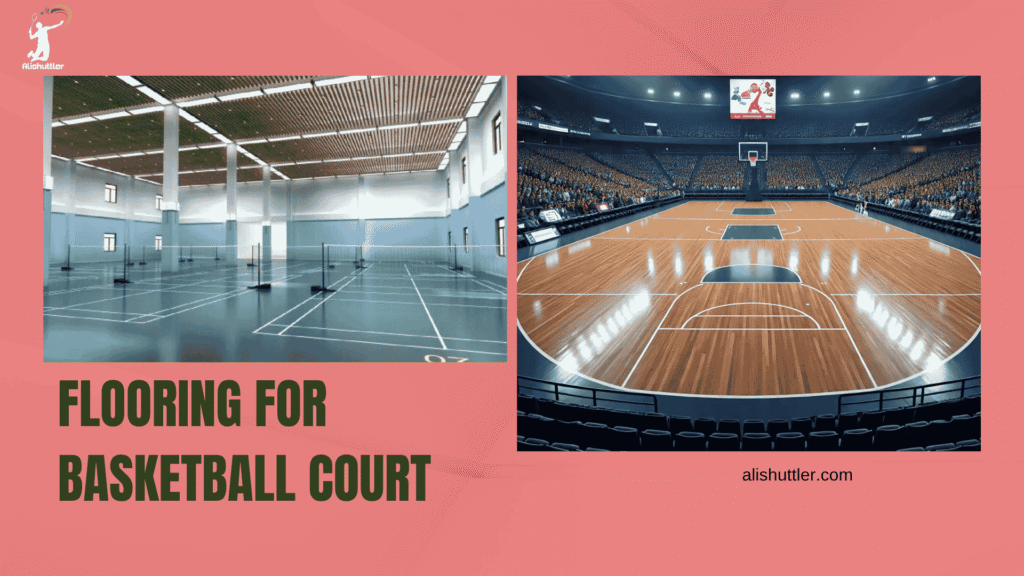
4. Concrete
Concrete is a rugged, economical choice for outdoor courts. It can be painted or textured to increase traction and clarify lines. Its hard surface means the ball bounces well, but this can be hard on joints.
It’s not shock-absorbent, which can be harsher on your body in the long run. Concrete resists weather exceptionally, requiring minimal maintenance besides sweeping and line re-painting.
Yet, cracks can appear after years of use or with significant fluctuations in temperature.
5. Asphalt
Asphalt is another common material for outdoor courts. It’s cheap and simple to install. Its bit of elasticity allows it to withstand fissures caused by fluctuations in heat and cold, making it ideal for a variety of climates.
Upkeep involves sealing and repairing cracks. The floor gets soft in hot weather and hard in cold, which could impact play. Asphalt courts endure for decades, but require consistent maintenance to appear and perform their finest.
Selection Factors
Selecting basketball court flooring, such as vinyl sports flooring or outdoor basketball court tiles, involves balancing a number of considerations for each player and the facility. Player safety, performance, budget, and court location all factor into ensuring the surface matches the use and endures through multiple games.
Player Safety
Basketball is high-impact stuff, so safety is a central focus. The primary role of the flooring is to reduce the chance of injuries such as sprains or chronic joint damage. Great floors absorb shock and cushion falls, relieving stress from knees and ankles.
Most professionals claim that a basketball court floor should provide no less than 50% shock absorption to protect the players. Floors have to be slip-resistant, too. If the surface is too slick, slip-and-fall injuries become prevalent.
International protocols, like those of FIBA or other sports organizations, assist in selecting secure surfaces. Regardless of the composition, frequent inspections and prompt patch-ups are necessary to maintain a play-safe surface for each and every game.
Performance
The type of flooring alters the game feel. Maple hardwood is popular in indoor courts because it provides consistent ball bounce, excellent traction for rapid movements, and the appropriate balance of rigidity and flexibility.
For outdoor courts, acrylic floors excel for their durability and all-weather functionality. Uniformity of ball bounce and traction is crucial for equitable and fun play. A floor that doesn’t contain these can screw up player timing or make quick stops more difficult.
The degree of comfort counts, as hard or uneven floors can wear out players quicker, especially in long games or tournaments. Material selection impacts the player’s ability to run, cut, or jump. A good floor can enhance speed and agility, while a bad one can restrict skill or even induce additional fatigue.
Budget
Pricing is all very much dependent on the medium and setup. Maple hardwood has greater initial expenses and requires more maintenance, but it remains for decades and is the standard for professional-level indoor courts.
Acrylic and synthetic styles are less expensive initially and are generally less of a hassle to clean, particularly when outside. For schools or community centers, funding or grants could assist in subsidizing the expense.
When you factor in long-term cleaning and repair needs, the scale can be tipped between saving now and spending less in the long run. Putting more up front can save headaches and expenses down the road, but budget constraints indicate lower-priced alternatives.
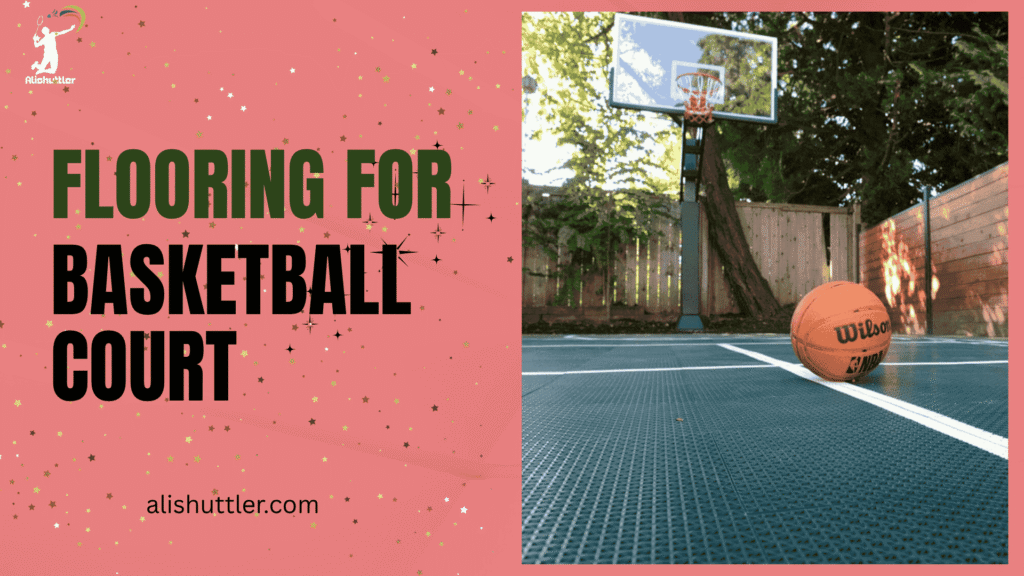
Location
Where the court sits weighs in. Outdoor courts require rugged, weather-resistant Flooring for basketball courts such as acrylic to withstand sun, rain, and temperature fluctuations. Indoor courts have additional options, but humidity and temperature variations still influence floor expansion or contraction.
Coverage, configuration, and intended use, backyard fun, league play, or multi-sport inform the ideal floor selection. Location checks in advance assist in identifying any restrictions or unique requirements the site imposes.
Installation and Care
A good installation is at the core of a Flooring for basketball courts quality and longevity. Nailing the subsurface gets priority. It has to be clean, level, and ready for close tolerances a level tolerance of +/- 1/8″ in a 3m radius. This keeps the court nice and flat and safe for play, especially when using high-quality basketball floor materials.
For outdoor basketball courts, it’s wise to provide for 1to1.5 inches of space for thermal expansion, particularly if the weather fluctuates significantly. Indoor basketball courts have additional requirements as well, such as a sprung system below the surface. These assist in shock absorption and provide a superior bounce for athletes.
There are two main types: solid wood, often maple, which gives that classic look and feel, and engineered wood, which can handle changes in moisture better. Installation of a court can require as much as 15 hours and create approximately 320 pounds of sawdust. Tools required are a measuring tape, chalk box, plumb bob, utility knife, and safety glasses.
Jumping steps or messing up the prep can result in loose boards, uneven areas, or warping. Your best bet is to hire professionals. They know how to catch problem areas early and ensure all regulations are complied with, especially when installing outdoor court tiles.
For concrete courts, sealing and curing right keeps the floor in great shape for decades, requiring fewer major repairs. For wood floors, the base has to be dry, and all the pieces have to fit tightly. Too tight or too loose boards will be trouble later, impacting the overall longevity of your athletic court.
Once the court is in, then comes keeping it clean and in shape! Dust and grit can wear down the finish, so sweeping and mopping regularly are important. For wood, a damp mop is never wet.
Steer clear of any strong cleansers that may eat away the finish or leave behind buildup. On outdoor Flooring for basketball court, sweep away leaves, dirt, and draining water. Every couple of months, look for loose boards, cracks, or areas where the finish is wearing through.
Inspect for any indication of shifting, such as gaps or buckling, and repair immediately. Typical problems over time are worn paint lines, faded finish, loose floorboards or little cracks, especially in heavy-use areas.
These need quick fixes: touch-up paint, sanding and resealing, or tightening boards. A cleaning and checks monthly or quarterly schedule set keeps the Flooring for basketball court safe and looking good.
Environmental Impact
Choosing the proper Flooring for basketball court, whether it be an indoor basketball court or an outdoor basketball court, is more than just playability or style. The materials used, like vinyl sports flooring or wood flooring, significantly influence the environmental impact footprint, affecting resources and air quality in communities.
Material Lifecycle
The environmental impact of basketball court flooring begins with the sourcing of raw materials. Take old-school hardwood floors, for example they’re using timber that could factor into deforestation if it’s not from certified forests.
Synthetics such as polyurethane and PVC are derived from petrochemicals, and their manufacture can release VOCs and generate non-biodegradable waste. Recycling is different for each material. Rubber flooring from recycled tires breathes new life into waste otherwise bound for the landfill.
At the end-of-life, cork and bamboo Flooring for basketball courts are biodegradable options. They degrade more readily and cost less to grow, so they’re appealing to operations aiming to minimize their environmental impact. Environmental certifications can be useful in helping to indicate which products meet rigorous green standards.
LEED certification is a famous example, which is recognized worldwide for green building, including sports courts. Any products with this or similar certifications are more likely to be sustainably sourced, produced, and managed in terms of environmental impact.
Choosing products with a smaller natural resource footprint can count. Bamboo, for instance, grows back quickly and requires hardly any pesticides. Cork is harvested without felling trees. Opting for these instead of more unsustainable alternatives can contribute to protecting ecosystems and supporting sustainability.
Climate Effects
Different climates place different stresses on basketball court flooring. High humidity or torrential rains can warp or mold hardwood, and extreme heat can break down some synthetic surfaces at a more rapid pace. Material that is durable in one area might not make it through the season in another.
Choosing flooring that can withstand temperature and moisture fluctuations is important. Synthetic acrylic Flooring for basketball courts made with premium, environmentally friendly components can withstand these fluctuations more adeptly and reduce replacements.
Outdoor courts face threats from weather, such as sun damage or water accumulation. Some people have had success installing UV-protected surfaces or better drainage. In areas with tough winters, leveraging pliable substances that resist fracturing is essential.
Maintenance requirements vary by climate. In damp regions, periodic cleaning and resealing will prevent molds and mildew. In dry or hot areas, looking for cracks and fading can catch issues before they escalate.
Air Quality
Indoor air quality is significantly impacted by Flooring for basketball courts, especially in spaces like indoor basketball courts. Certain synthetic floors, such as vinyl sports flooring, can emit VOCs, affecting the health of players and spectators. Opting for low- or natural-emission certified flooring can help maintain cleaner air.
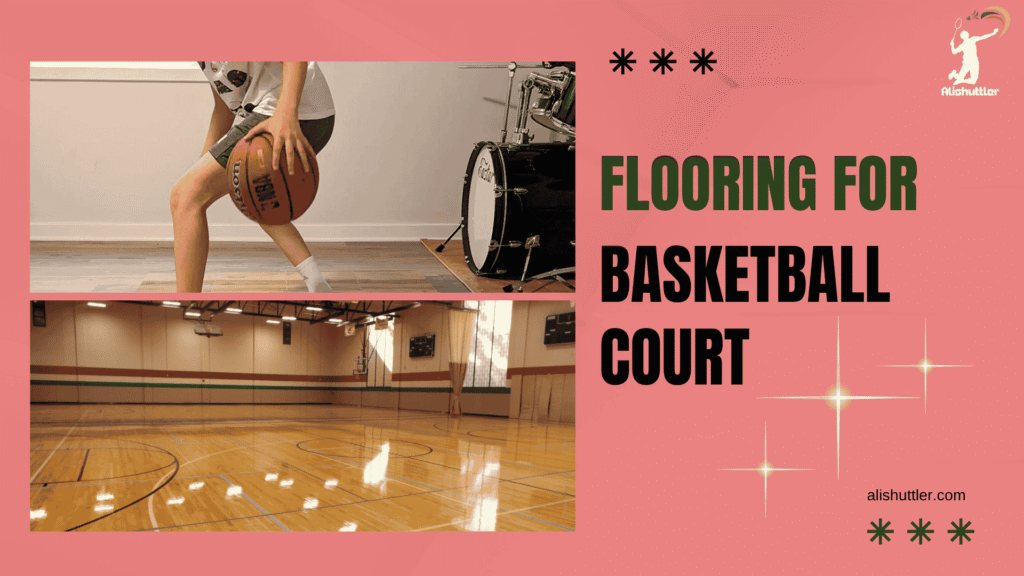
Eco-Friendly Practices
Green installation and maintenance practices reduce the carbon footprint of sports courts. Low or no VOC adhesives, recycled waste, and just a straight-up plan for waste management all make a difference.
Even baby steps, like opting for green cleaning products, count.
Modern Innovations
Basketball court Flooring for basketball courts has undergone huge transformations over the years. Modern innovations are defining the look and feel of courts, with an emphasis on performance, safety, and durability. Lots of makers are now utilizing recycled rubber and other reclaimed materials, reducing waste and assisting the planet.
These Flooring for basketball courts are designed to last longer, requiring less maintenance and fewer repairs, reducing cost over the lifetime of the floor. Shock absorption is now a prime objective. Floors are designed to reduce strain on joints and muscles, which keeps players injury-free. Improved shock absorption reduces fatigue, allowing athletes to push further, harder, and longer.
Traction is another highlight. Flooring for basketball courts today has anti-slip finishes and surface treatments that reduce the risk of slips and falls. This is important for both pros and young players. These treatments are effective even on wet courts, making them safer for all.
Incredible smart sensors and tech are creeping into sports Flooring for basketball court. These sensors monitor, such as the location of ball landing, pace, or foot pressure. Certain configurations provide live feedback, which coaches and players use to identify weak areas or optimize skills.
They even have floors that light lines or zones for drills and games. It makes practice more playful and keeps fans involved during games. Floor installation has changed as well. New systems install quicker and are portable or flexible.
This enables schools, gyms, and clubs to transition between sports or events with less friction. A lot of Flooring for basketball courts today is sold in panels or rolls that click or lock together. This reduces installation time and helps maintain the court’s level and smoothness.
Custom floors are the norm now. Athletes can choose their perfect mix of traction, spring, and cushion for their game or venue. Other courts go as far as using AR or VR add-ons, which are beginning to assist with training and game day shows.
As an increasing number of teams and venues request such features, manufacturers continue to innovate by combining technology and safety with play.
Beyond The Surface
Basketball court flooring is not just a flat surface for play; the choice of outdoor basketball court tiles or indoor Flooring for basketball court can significantly impact the experience. Every layer and detail counts, from comfort and grip to sound and aesthetics, enhancing the overall enjoyment for players and fans.
The Feel
The feel of a court is dictated by the material and construction. Wood, maple in particular, is the professional and college standard for many courts. It provides a balance of traction and slip, allowing ball players to speed across the field or court and pivot with precision.
Concrete courts, typically outdoor, are more rigid. They provide less cushioning, which can strain joints over time. Sprung wood systems, as seen on top-tier courts, install a layer below the wood that absorbs each step. This configuration provides a minimum of 50% shock absorption, reducing injury risk and fatigue.
The way a court feels underfoot can alter player behavior. When grip is on point, athletes can count on their shoes to hold firm for a sharp pivot or leap. Too slick, and athletes can slide. Too coarse, and it can impede walking or lead to slips. Comfort counts as well. A court that just feels “right” aids players in concentrating on the game, not their sore knees or ankles.
Some like the bounce of wood, others are accustomed to the solidity of concrete. Whether in school gyms or big arenas, the right feel can enhance skill and confidence at all levels.
The Sound
Audio is in every game. The ball bounces, the shoe squeaks, and the teammate calls all reverberate uniquely on every floor. Wood courts produce a crisp, staccato noise that quite a few associate with pro games. Concrete courts may sound duller and less lively.
Good acoustics allow players to talk and listen during a match. Too much reverberation in a court can make it difficult to hear, rendering teamwork challenging. Certain contemporary floors incorporate noise-cutting materials, rendering the space less cacophonous and more contemplative.
This can help to keep players calm and enhance their consciousness. In big gyms, controlling noise can make the game more enjoyable for teams and fans alike.
The Look
What your basketball court looks like can create the atmosphere before the initial whistle. Maple floors with a fresh, smooth finish are deliciously classic. The color counts! Regulations dictate that the floor has to be flat, with a light reflectance of between 0.25 and 0.50, so lines and markings show up crisp for all.
Custom colors, bold lines, and big logos all amp up team spirit and make the court pop. Branding helps teams feel at home, and fans have something to cheer for. For community gyms and schools, a shiny, clean court can attract more players and make the space inviting.
A clean floor conveys care and pride, while faded or mangled floors can repulse people. The aesthetics of the court isn’t merely decorative it’s all about cultivating an environment where people desire to play and convene.
The Details
Prepping a top athletic court can consume 15 hours and create 700 pounds of sawdust. A sealed concrete outdoor basketball court can last for decades. It could cost you $60,000 to sand and refinish a wood flooring court every three years.
Final Thoughts on Flooring for basketball court
Selecting the perfect Flooring for basketball court defines the experience of the sport. Wood provides an old-school bounce, while synthetic varieties withstand soggy sneakers and hectic fitness centers. Proper maintenance makes floors safe and slick. New tech floors are easier to clean and repair, and reduce waste.
Courts today can employ smart sensors to monitor play and even enhance safety. Smart choices make for better games and less damage to the planet, from the mini gym to the mega arena. For your new or refreshed court, check out yours, determine your budget, and consider your choices. Pass on your court tales or advice to others in need of the ultimate place to hoop.
Frequently Asked Questions
What are the most common flooring materials for basketball courts?
The most common are maple hardwood for professional courts, along with synthetic surfaces like vinyl sports flooring and modular outdoor court tiles.
How do I choose the best flooring for a basketball court?
Consider factors like usage, budget, maintenance, and safety when choosing athletic court flooring. Maple hardwood is ideal for professional play, while vinyl sports flooring offers an affordable and low-maintenance option for community or school gyms.
How is basketball court flooring installed?
Installation varies by material; for instance, hardwood flooring requires expert installation with precise subfloor preparation, while vinyl sports flooring and modular floors can be set up DIY.
What maintenance does basketball court flooring need?
Hardwood floors require consistent cleaning, refinishing, and humidity control, while synthetic and modular floors, like vinyl sports flooring, generally need sweeping and occasional mopping with mild detergents.
What is the environmental impact of basketball court flooring?
PMaple hardwood is a popular choice for indoor basketball courts, but while it’s natural, it needs to be sourced responsibly. Synthetic floors, like vinyl sports flooring, might utilize recycled raw materials but can create waste at end-of-life. Many manufacturers offer green options these days.
Are there modern innovations in basketball court flooring?
Innovations in athletic court flooring include shock-absorbing layers, heightened traction, noise control, and green materials, enhancing the performance of indoor basketball and outdoor sports tiles.
Can basketball court flooring be used for other sports?
Let’s face it, most athletic court floors are multi-purpose. Synthetic and modular surfaces work well for volleyball, badminton, and futsal, making them ideal for outdoor basketball courts.


